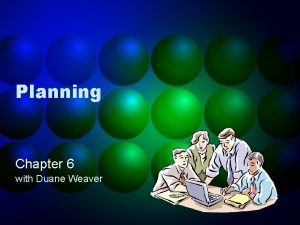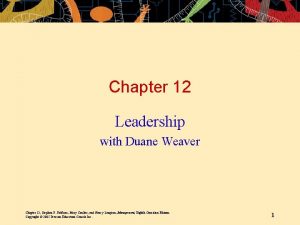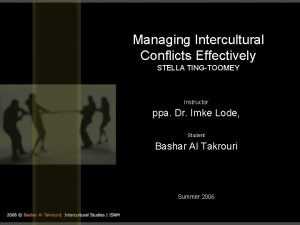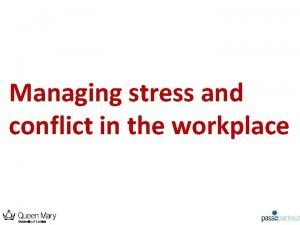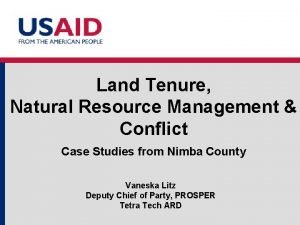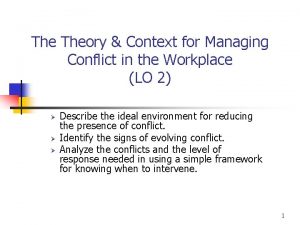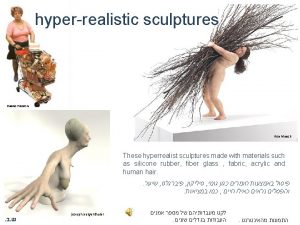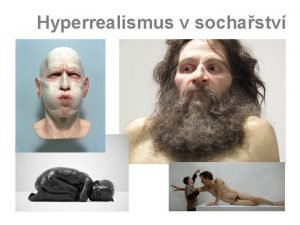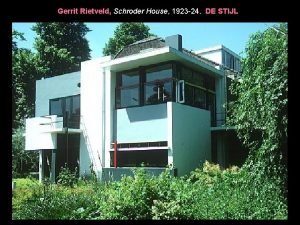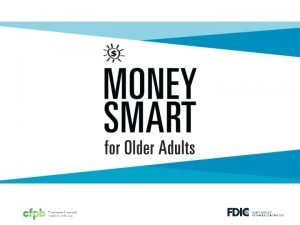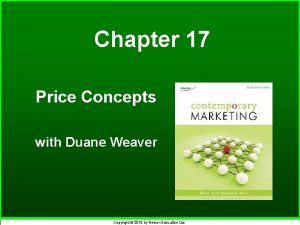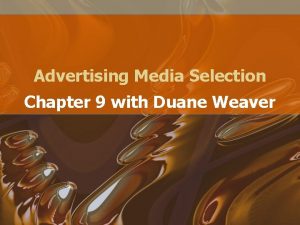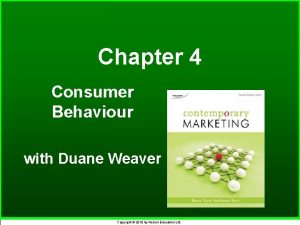Managing Conflict Chapter 9 with Duane Weaver What












- Slides: 12

Managing Conflict Chapter 9 with Duane Weaver

What is Channel Conflict? o o In channel distribution, conflict is not negative, rather, some conflict actually strengthen and improves a channel. “Channel conflict arises when the behavior of a channel member is in opposition, to its channel counterpart. It is opponent centered and direct, in which the goal or object sought is controlled by the counterpart. ” Coughlan, Anderson, Stern, Adel, p. 238

Types of Conflict o o Latent conflict – norm in marketing channels …conditions are right for contention by the organization is unaware of it (lacking perception). Perceived conflict – cognitive, emotionless and mental …channel member senses some sort of conflict exists; “all in a days work”. Felt conflict – affective conflict, when emotions do enter the equation. Manifest conflict – visible, expressed in behaviour. Usually seen as blocking each other’s initiative or withdrawing support.

Measuring Conflict o o Count – counting # of Issues Importance – weighting or scale Frequency – frequency of disagreement Intensity – of dispute (how disparate) N CONFLICT = ∑ Importancei X Frequencyi X Intensityi i=1 o Index of Conflict – can be used to compare members in a channel

Calculating Conflict – Practice Exercise (take home – answers will be on class website) o Analyzing 3 issues in conflict with 8 car dealers and the manufacturer: n Disagreement about volume discount programs for carrying your own inventory (small car dealers see no advantage, big dealers see lots) o o o n Requirement to participate in National Advertising program o o o n Importance of issue 4 small = 4/10 and the 4 big = 8/10 Frequency is monthly (every shipment) Intensity is very disparate 9/10 Importance = 2/10 Most dealers prefer their own program (especially the larger ones, however, it is seen as a necessary evil of being part of being a franchise) Frequency = 2 times a year Intensity is not too disparate 4/10 comparatively Warranty return administration requires quintuplicate forms and can take up to 90 days to receive payment on labour and parts expended. o o o Importance = 10/10 for all dealers Frequency = every meeting (16 times a year) and in additional at least 2 complaints per month per 8 dealers Intensity is the same as for the National Advertising program

Desirable Conflict can induce: 1. More frequent and effective communication 2. Create outlets for grievances 3. Members to critically review past actions 4. The more equitable split of resources 5. The balance of power to shift more equitably 6. Standardization for dealing with future conflict and boundary delineation

Damage from Intense Conflict o High channel conflict can create costs …as shown in fig. 9. 1 on Page 245. n Trust diminished n Commitment to relationship in jeopardy n Reduction in financial rewards n Reduction in psychosocial benefits and gratification from relationship

Sources of Conflict o Competing goals n o Perceptions of reality n n n o Margins, unit sales, expense control, inventory, incentives, promotions, allowances, volumes and thresholds, market penetration objectives… Attributes of product or service are… Application served and segments served What is the competition Domain of control n More often a perception that the other channel member is not pulling their weight for a domain that should be theirs.

Fueling Conflict o o o The Conflict propensity is strongly correlated to the quantity of historical incidence Threats – induction by punishments and/or sanctions (Coercion can lead to escalating conflict and ultimate channel damage) Unbalanced power is indicative of short-term relationship expectations – propensity for conflict is increased

Conflict RESOLUTION STRATEGIES o Information-Intensive Mechanism n n o Third-Party Mechanism n n o Risk sharing sensitive information with trust and cooperation or via a diplomat Joint membership in Trade Associations Personage exchange Co-aptation (involving channel members in corporate decisions) Mediation Institutionalized Arbitration process Building Relational Norms n Flexibility, Info Exchange, and Solidarity

Styles of Conflict Resolution o o o See Fig. 9. 2 on Page 269. Accommodation Avoidance Competition or Aggression Compromise Collaboration or Problem Solving

Thanks o o Work through the Conflict Measurement Exercise and check your answers with the web Mid-Term questions?
 Duane weaver
Duane weaver What leadership traits did weaver exhibit?
What leadership traits did weaver exhibit? Managing intercultural conflict effectively
Managing intercultural conflict effectively Cialdini's 6 principles of persuasion
Cialdini's 6 principles of persuasion Conflict in psychology
Conflict in psychology Managing stress and conflict in the workplace
Managing stress and conflict in the workplace Ways of managing conflict in the community
Ways of managing conflict in the community Managing conflict theory
Managing conflict theory John de andrea
John de andrea Hyperrealismus
Hyperrealismus Schroder house analysis
Schroder house analysis Duane pinto
Duane pinto Doc duane adult topics
Doc duane adult topics
